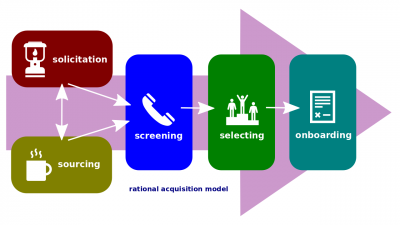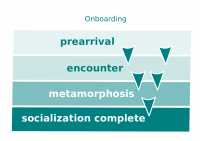Difference between revisions of "What Recruitment Is"
(→Script) |
|||
| Line 16: | Line 16: | ||
:The [[employer]] is on the one side of this process. Supposedly, this ''employer'' has identified its needs to hire the [[employee]] who is qualified, able, and available to satisfy the needs. | :The [[employer]] is on the one side of this process. Supposedly, this ''employer'' has identified its needs to hire the [[employee]] who is qualified, able, and available to satisfy the needs. | ||
| − | :Ideally, one or more [[ | + | :Ideally, one or more [[worker]]s are on another side of this process. So, the ''employer'' challenge is how to reach out to them to let them know about the ''vacancy'' to make them interested. When the interested apply, they become [[employment candidate]]s. |
:The next steps of this process are to screen them, choose the few who are best qualified, able, and available to satisfy the needs, to negotiate possible [[employment]], select the best match, and offer the job. | :The next steps of this process are to screen them, choose the few who are best qualified, able, and available to satisfy the needs, to negotiate possible [[employment]], select the best match, and offer the job. | ||
Revision as of 15:26, 8 May 2020
What Recruitment Is (hereinafter, the Lectio) is the second lesson part of the Recruitment Essentials lesson that introduces its participants to recruitment and related topics.
This lesson belongs to the Introduction to Recruitment session of the CNM Cyber Orientation. The Orientation is the second stage of the WorldOpp Pipeline.
Contents
Content
The predecessor lectio is Who Whistleblower Is.
Key terms
- Recruitment. The process of filling employment vacancies with people.
- Onboarding. The mechanism of integrating a new employee into the enterprise and its culture.
Script
- Recruitment is the process of filling employment vacancies with people. The Rational acquisition model describes that process.
- The employer is on the one side of this process. Supposedly, this employer has identified its needs to hire the employee who is qualified, able, and available to satisfy the needs.
- Ideally, one or more workers are on another side of this process. So, the employer challenge is how to reach out to them to let them know about the vacancy to make them interested. When the interested apply, they become employment candidates.
- The next steps of this process are to screen them, choose the few who are best qualified, able, and available to satisfy the needs, to negotiate possible employment, select the best match, and offer the job.
- Onboarding is the mechanism of integrating a new employee into the organization and its organizational culture. If the job offer is accepted, the employer onboards the selected candidate as a new employee.
- The recruitment process is rarely fast and simple on either side. Concerning its complication, this process can be compared with arranging a marriage.
Employment Vacancies is the successor lectio.
Quiz
- Every statement below is split into one true and one false question in the actual exam.
- Recruitment is (not) the process of filling job vacancies with people.
- Recruitment includes (or does not include) sourcing.
- Recruitment includes (or does not include) source screening.
- Recruitment includes (or does not include) source selection.
- Recruitment is (not) the process of finding available and qualified candidates to fill in job vacancies.
- Source selection is (not) the process of finding available and qualified candidates to fill in job vacancies.
- Source selection is (not) the process of filling job vacancies with people.
- Recruitment is (not) the process of selecting those candidates who offer the best solutions to the organization's needs.
- Source selection is (not) the process of selecting those candidates who offer the best solutions to the organization's needs.
- Recruitment is (not) investigation undertaken in order to find and evaluate the data relevant to credentials of employment candidates.
- Source selection is (not) investigation undertaken in order to find and evaluate the data relevant to credentials of employment candidates.
- Every statement below is split into one true and one false question in the actual exam.
- Sourcing is (not) the process of filling job vacancies with people.
- Sourcing is (not) the process of finding available and qualified candidates to fill in job vacancies.
- Sourcing is (not) investigation undertaken in order to find and evaluate the data relevant to credentials of employment candidates.
- Sourcing is (not) the process of selecting those candidates who offer the best solutions to the organization's needs.


